Food课件
food主题英语课件.

food主题英语课件.一、教学内容二、教学目标1. 掌握食物分类词汇,并能灵活运用;2. 学会使用形容词和副词描述饮食特点;3. 运用所学句型谈论饮食习惯和饮食健康;4. 提高学生的听说读写能力,培养跨文化交际意识。
三、教学难点与重点教学难点:食物分类词汇的掌握、形容词和副词的运用、饮食与健康原则的理解。
教学重点:灵活运用所学词汇和句型进行饮食话题的讨论。
四、教具与学具准备教具:PPT、黑板、卡片、录音机;学具:课本、练习本、彩色笔。
五、教学过程1. 导入:通过展示一组关于世界各地的美食图片,引发学生对食物话题的兴趣。
2. 新课内容展示:a. 学习食物分类词汇,进行词汇接龙游戏;b. 学习形容词和副词,用卡片进行配对练习;c. 学习饮食相关句型,通过角色扮演进行对话练习;d. 学习饮食与健康原则,进行小组讨论。
3. 例题讲解:针对本节课的重点和难点,给出例题进行讲解。
4. 随堂练习:让学生根据所学内容,进行听力、口语、阅读和写作练习。
六、板书设计1. 食物分类词汇;2. 形容词和副词;3. 饮食相关句型;4. 饮食与健康原则。
七、作业设计1. 作业题目:以小组为单位,编写一段关于饮食与健康话题的对话。
2. 答案:略。
八、课后反思及拓展延伸2. 拓展延伸:鼓励学生课后收集更多关于食物和饮食健康的资料,进行课堂分享,提高学生的跨文化交际能力。
同时,组织学生参加有关美食制作的实践活动,使学生在实践中掌握所学知识。
重点和难点解析1. 教学内容的难点与重点;2. 教学过程中的新课内容展示;3. 作业设计;4. 课后反思及拓展延伸。
一、教学内容的难点与重点教学难点:食物分类词汇的掌握、形容词和副词的运用、饮食与健康原则的理解。
补充说明:1. 食物分类词汇的掌握:为学生提供一份食物分类词汇表,包含各种食物的名称,如水果、蔬菜、肉类、海鲜等。
在教学过程中,通过词汇接龙、卡片配对等游戏形式,帮助学生记忆和巩固这些词汇。
英语课件《Food》

英语课件《Food》英语课件《Food》设计意图:《纲要》指出:教育内容的选择既要贴近幼儿的生活,又要有助于开拓幼儿的经验和视野。
我所选的内容《Food》是幼儿园中班英语教材中的一个单元主题。
此活动选材来源于生活,又能服务于幼儿的生活。
《Food》活动中所涉及的英语单词都是日常生活中孩子们经常看到、接触得到的,因为孩子的生活离不开食物。
而且这些内容在孩子们经验范围之内,能够引起他们的.兴趣,同时孩子们生活中也会有很多机会练习。
根据中班孩子的年龄特点,考虑到本班幼儿的英语发展水平,我设计了这一教学活动。
活动目标:1、学习与食物有关的单词:egg(鸡蛋) 、milk(牛奶)、bread (面包)。
2、通过看、听、说等方式,让幼儿初步掌握单词的发音方法,鼓励幼儿积极、大胆地朗读单词。
3、激发幼儿学习英语的兴趣,体验活动快乐。
活动准备:课件、单词卡、食物图片教学过程:一、准备部分。
1.组织幼儿坐好,并进行师幼问好。
如:师:good morning class! 幼儿:good morning teacher!2.热身运动:《Finger play》二、基本部分。
1.谈话导入课题。
(1)师问:小朋友们想不想快快长大?要怎样才能长大呢?不吃东西能长大吗?(2)教师小结:小朋友们回答得很对。
食品,是人类不可缺少的东西。
古人说“民以食为天”,说明食品和人类息息相关,人类无法离开食品。
如果没有了食品,人类将会无法生存。
今天我就让小朋友来认识一些常见的食物。
2.播放课件学习单词。
(1)先让幼儿通过看课件说出都有哪些食物(用汉语说出)。
(2)引导幼儿初步学习食物的英文名称。
要求幼儿注意单词的发音方法(3)鼓励幼儿积极、大胆朗读单词3.单词巩固。
(1)播放ppt让幼儿跟着课件朗读单词。
(2)播放课件:让幼儿进一步认读单词。
(依次出示食物图片,让幼儿尝试说出英语单词,教师及时给予纠正。
)4.游戏:找朋友(1)出示课件:教师依次朗读单词,指名幼儿说出相对应的图片。
人教版一年级起点小学三年级上册英语《Unit 3 food》课件
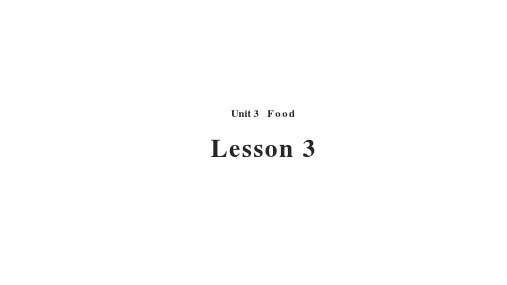
But his parents say, “No ice-cream and cola! They
are not good for you.”
Read and number
BilBl’es gfaomodilyfoirs swbr.i意tin为g“a 对sh某op人pi有ng好l处ist”. His mother wan要ts记so住mfeobr的re固ad定, e搭gg配s哦an!d juice. His father wants sicoem-思cerec考aamk:e,a黄引fnrd色用uict的别oala短人n.d语的m是话ilk什时. B么应il意注l w思意an呢什ts?么so呢m?e apples, But his parents say, “No ice-cream and cola! They are not good for you.”
are not good for you.”
1.这里意为“不能,不要”; Read and number 2.这句话是祈使句;
3.构成:no+名词。“不要做某事”。 Bill’sEfga:mniolyruisnwnirnitgi不ng要a 跑sh步opping list. His mother
wants some bread, eggs and juice. His father wants some思ca考ke:, f这ru里it a的ndnom怎ilk么. B翻il译l w呢an?ts句so子m中e apples, ice-cr没ea有m谓an语d 宾co语la.成分,如何解释呢?
Bill想要一些苹果,冰淇淋和可乐。
Bill’s family is writing a shopping list. His mother wan但可ts是乐soB!mil他le的们b爸r对e爸a你d说,的e,g身g“体s a不不n能好d 吃j。u冰i”ce淇. H淋i和s father wants some cake, fruit and milk. Bill wants some apples, ice-cream and cola. But his parents say, “No ice-cream and cola! They are not good for you.”
英语主题Food精品PPT课件
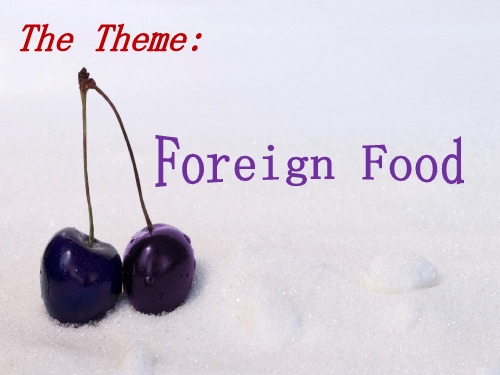
Canadian specialty food
• 量足价廉可以说是加拿 大菜的特色。
• 两大海岸是鳕鱼、鲑鱼 的宝库,在这里可以品 尝到美味熏鲑鱼和鲑鱼 牛排。
Cheap and enough is the special Two Coast cod, salmon treasure trove, where you can taste the delicious smoked salmon and salmon steaks.
加拿大人的饮食以肉类、蔬菜为主,面食、米饭为辅。他们特别喜欢吃 沙丁鱼和野味。蔬菜偏好生吃,主要有西红柿、芹菜、菜花、洋葱、土豆、黄 瓜等。加拿大人口味清淡,偏甜酸,不喜欢太咸 的食物。
加拿大的快餐业发展很快,种类很多,如热狗、意大利馅饼、汉堡包、希腊肉 棍、美国炸鸡、墨西哥玉米面卷肉、中国份饭等。
餐饮礼仪Dining Etiquette
在加拿大,赴宴时最好到花店买一 束鲜花送给主人,以表达自己的谢意。在餐 桌上,男女主宾一般分别坐在男女主人的右 手边。饭前先用餐巾印一印嘴唇,以保持杯 口干净。进餐时,左手拿叉,右手拿刀,刀 用完后,放在盘子边上。吃东西时不要发出 声音,不宜说话,不要当众用牙签剔牙,切 忌把自己的餐具摆到他人的位置上。加拿大 人认为正确、优雅的吃相是绅士风度的体现。
The Theme:
小组成员
4-4-82:
莫泽永
欧诗诗
孙迪
蒋家婵
5-3-57
周杨
杨1.Canadian food ● 2.American food ● 3.Mexican food
1. Canadian food:
Food categories
Canadians are eating the meat, vegetables, pasta, rice is supplement. They especially like to eat sardines and game. Preference for raw vegetables, mainly tomatoes, celery, cauliflower, onions, potatoes, cucumbers and so on. Canadians light taste, sweet and sour side, do not like salty food Canada's fast-food industry has developed rapidly, many types, such as hot dogs, pizza, hamburgers, Greece Rougun, American fried chicken, Mexican cornmeal volumes of meat, rice and other parts of China. Canada also like to eat chinese vegetables, Jiangsu cuisine, Shanghai cuisine, Shandong cuisine.
人教版一年级英语下册《FOOD》课件含讲稿

人教版一年级英语下册《FOOD》课件含讲稿一、教学内容本节课选自人教版一年级英语下册《FOOD》章节,主要内容包括:食物名称、饮食习惯以及相关问答句型。
详细内容涉及Chapter 2的Lesson 1至Lesson 3,包括单词:cake、banana、apple、orange、milk、juice、bread、egg、rice;句型:What do you like to eat?、I like to eat、Do you like?、Yes, I do./No, I don't.二、教学目标1. 学生能够听懂、会说、认读本章所学的食物名称和饮食习惯相关单词及句型。
2. 学生能够运用所学知识进行简单的生活场景对话,如点餐、询问喜好等。
三、教学难点与重点教学难点:单词和句型的认读、运用;生活场景对话的构建。
教学重点:食物名称、饮食习惯和相关问答句型的掌握。
四、教具与学具准备教具:PPT课件、实物食物模型、单词卡片、磁铁。
学具:学生用书、练习本、彩笔。
五、教学过程1. 导入(5分钟):通过展示实物食物模型,引导学生用英语说出食物名称,激发学生学习兴趣。
2. 新课内容展示(10分钟):利用PPT课件,展示本节课所学的食物名称和句型,让学生跟读、模仿。
3. 例题讲解(10分钟):结合PPT课件,讲解句型的用法,并进行示范。
4. 随堂练习(10分钟):学生两人一组,运用所学句型进行问答练习。
5. 小组活动(15分钟):学生分成小组,进行“点餐”场景的角色扮演,巩固所学知识。
六、板书设计板书分为两部分:左侧列出本章单词,右侧展示重点句型。
七、作业设计1. 抄写本章单词,每个单词写5遍。
A: What do you like to eat?B: I like to eat3. 答案示例:A: What do you like to eat?B: I like to eat cake and banana.A: Do you like milk?B: Yes, I do.八、课后反思及拓展延伸1. 课后反思:关注学生的学习反馈,了解他们在学习过程中的困惑,针对问题进行个别辅导。
关于食物的 ppt课件
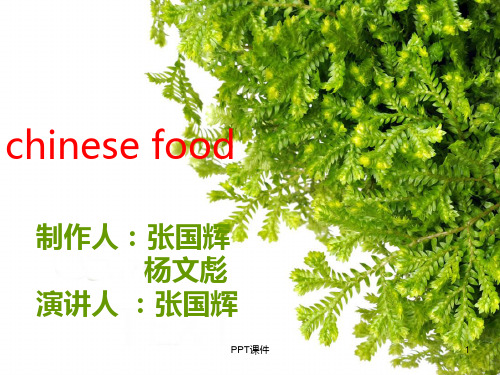
水果糖konfyt陈皮orange peel棉花糖 cotton candy太妃糖toffee香瓜子
sunflower seed南瓜子pumpkin seed藕粉 lotus root starch馅子filling
便当PlPuTn课c件hbox自助餐buffet零嘴snack
25
日本料理: 味噌汤miso shiru天妇罗(甜不辣) tempura寿司shushi铁板烧teppanyaki
Sauce
生菜: Lettuce 黄瓜: cuke 葱: scallion 胡萝卜: carrot 玩具: toy 杯: Mug 优惠券: Saver ticket 纸巾: Paper tower 手套: glove 吸管: Straw 搅拌棒: muddler 勺子: scoop 奥尔良: Orleans
PPT课件
麻酱面
19
duck with noodles 鸭肉面
PPT课件
20
eel noodles 鳝鱼面
PPT课件
21
seafood noodles 乌龙面
PPT课件
22
B 饮食用语
汉堡包: Hamburger 鸡肉卷: Chicken Loaf 原味鸡: Original Recipe 烤鸡翅: Roast Chicken Wings 上校鸡块:Colonel’s Crispy Chicken
饮品: 饮料beverages/quencher红茶black tea锡兰上等红 茶Pekoe新茶sincha
烤鸡肉串Yakitori甜味烤猪肉teriyakii 日本火锅sukiyaki生鱼片sashimi清酒
saki芥末酱wasabi荞麦面soba noodles紫菜nori芥末
英语关于食物介绍-foodPPT课件
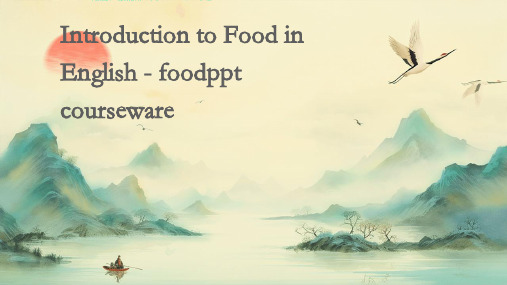
Pizza is another iconic American dish, with many different styles and toppings. It originates from Italy but has become so popular in the United States that it has been adapted and changed to suit American tastes.
European cuisine
Italian cuisine
Pizza, pasta, and Italian sauces are some of the most famous Italian dishes. Italians place a strong emphasis on fresh ingredients and simple yet delicious recipes, making their food both healthy and satisfying.
Chicken
A source of protein and iron. Some common types of meat include beef, chicken, pork, lamb, and veal.
A white meat that is a popular choice for many dishes. It can be roasted, grilled, or cooked in a curry dish.
African cuisine
Ethiopian cuisine
Ethiopian food is known for its unique flavors and spices, often using berbere, a spice mix that gives many Ethiopian dishes their characteristic heat and flavor. Dishes such as injera (a spongy bread) and various stews are common in Ethiopian cuisine.
Food食物英语课件[优质ppt]
![Food食物英语课件[优质ppt]](https://img.taocdn.com/s3/m/55852c18dd36a32d73758171.png)
what kind of dog doesn’t bite (咬)or bark(叫)?
hot- dog
Can you spell them?
fried chips hamburger chicken
crisps
salad
biscuits
sandwich
meat
nouns 名词
Countable Nouns
Do you ever drink beer?
I’m sure the right way to long life is
/uə/
/r/
/l/ /l/
drinking less and less beer.
/l/
/l/ /iə/
I like… and…. I don’t like … or…. I prefer…for breakfast/lunch/dinner.
Some other nouns
-f or fe +ves
a shelf →shelves, a knife →knives
man →men, woman →women, foot →feet, tooth →teeth, sheep →sheep, fish →fish, Chinese →Chinese
soup,porridge,rice,
noodles,dumplings,eggs……
Our new menu for school canteen(食堂)
Name Breakfast Lunch
Dinner
Fill the form, write a passage about your eating habit.
My Eating Habits
语文版中职英语(基础模块 上册)Unit 5《Food》ppt课件1

教材分析 学情分析 教法分析 教学过程 教学反思
第一 部分
• 1.food • 2.ice • 3.fried • 4.KFC • 5.beer • 6.tea
Review Match the two
parts
食物 蔬菜
设计目的:
肯德基 麦当劳 冰
通过这两种 形式的单词
健康的 油炸的 啤酒
复习,检测 学生对单词
编后语
• 同学们在听课的过程中,还要善于抓住各种课程的特点,运用相应的方法去听,这样才能达到最佳的学习效果。 • 一、听理科课重在理解基本概念和规律 • 数、理、化是逻辑性很强的学科,前面的知识没学懂,后面的学习就很难继续进行。因此,掌握基本概念是学习的关键。上课时要抓好概念的理解,
同时,大家要开动脑筋,思考老师是怎样提出问题、分析问题、解决问题的,要边听边想。为讲明一个定理,推出一个公式,老师讲解顺序是怎样的, 为什么这么安排?两个例题之间又有什么相同点和不同之处?特别要从中学习理科思维的方法,如观察、比较、分析、综合、归纳、演绎等。 • 作为实验科学的物理、化学和生物,就要特别重视实验和观察,并在获得感性知识的基础上,进一步通过思考来掌握科学的概念和规律,等等。 • 二、听文科课要注重在理解中记忆 • 文科多以记忆为主,比如政治,要注意哪些是观点,哪些是事例,哪些是用观点解释社会现象。听历史课时,首先要弄清楚本节教材的主要观点,然 后,弄清教材为了说明这一观点引用了哪些史实,这些史料涉及的时间、地点、人物、事件。最后,也是关键的一环,看你是否真正弄懂观点与史料间 的关系。最好还能进一步思索:这些史料能不能充分说明观点?是否还可以补充新的史料?有无相反的史料证明原观点不正确。 • 三、听英语课要注重实践 • 英语课老师往往讲得不太多,在大部分的时间里,进行的师生之间、学生之间的大量语言实践练习。因此,要上好英语课,就应积极参加语言实践活 动,珍惜课堂上的每一个练习机会。
英语课件——food食物
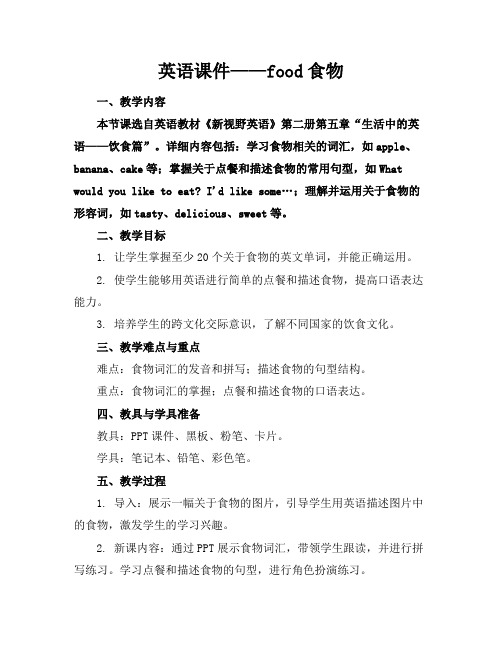
英语课件——food食物一、教学内容本节课选自英语教材《新视野英语》第二册第五章“生活中的英语——饮食篇”。
详细内容包括:学习食物相关的词汇,如apple、banana、cake等;掌握关于点餐和描述食物的常用句型,如What would you like to eat? I'd like some…;理解并运用关于食物的形容词,如tasty、delicious、sweet等。
二、教学目标1. 让学生掌握至少20个关于食物的英文单词,并能正确运用。
2. 使学生能够用英语进行简单的点餐和描述食物,提高口语表达能力。
3. 培养学生的跨文化交际意识,了解不同国家的饮食文化。
三、教学难点与重点难点:食物词汇的发音和拼写;描述食物的句型结构。
重点:食物词汇的掌握;点餐和描述食物的口语表达。
四、教具与学具准备教具:PPT课件、黑板、粉笔、卡片。
学具:笔记本、铅笔、彩色笔。
五、教学过程1. 导入:展示一幅关于食物的图片,引导学生用英语描述图片中的食物,激发学生的学习兴趣。
2. 新课内容:通过PPT展示食物词汇,带领学生跟读,并进行拼写练习。
学习点餐和描述食物的句型,进行角色扮演练习。
3. 例题讲解:讲解关于食物的例题,让学生学会如何运用所学词汇和句型。
4. 随堂练习:设计一些关于食物的选择题、填空题和简答题,让学生进行实践操作。
5. 小组活动:分组进行点餐和描述食物的口语练习,提高学生的实际应用能力。
六、板书设计1. 食物词汇:apple、banana、cake、hamburger、pizza等。
2. 句型:What would you like to eat? I'd like some…3. 形容词:tasty、delicious、sweet、sour等。
七、作业设计1. 作业题目:(1)默写本节课所学食物词汇。
(2)用英语写一篇关于自己喜欢食物的短文,不少于50词。
(3)完成课后练习册中的相关习题。
英语课件《Food》

英语课件《food》•Part One: Introduction to Food•Part Two: Vegetarian Foods•Part Three: Meat and Seafood•Part Four: Dairy Products•Part Five: Snacks and Fast Foods 目•Part Six: International Foods•Part Seven: Eating Healthily 录CHAPTERPart One: Introductionto FoodDefinition ExamplesDefinition of Food0102Carbohydrate s Fats and Oils Proteins Vitamins andMineralsWaterTypes of Food030405Importance of Food in Daily LifeFood provides the energy necessary for physical and mental activities.Energy SourceGrowth and DevelopmentHealth MaintenanceMental Well-beingFood provides the nutrients necessary for growth and development.Food provides the essential nutrients required for maintaining good health.A balanced diet can improve mental well-being and mood.CHAPTERPart Two: VegetarianFoodsVegetables Green vegetablesCarrotOnionBananarich in potassium, which isgood for children's cardiovascular health.Applerich in fiber and vitamin C, which can help children digest and absorb food.Orangerich in vitamin C and beta-carotene, which can help children's growth anddevelopment and improvetheir immunity.FruitsGrains and LegumesRiceBeanWheatCHAPTERPart Three: Meat andSeafoodMeatBeefSirloin: A lean cut with a firm texture and rich flavor, perfect for grilling orroasting.Striploin: A lean, tender cut with a mild flavor, often used for pan-frying orgrilling.MeatPorkLoin: A lean cut with a delicate flavor, perfect for roasting orgrilling.Chops: A bone-in or boneless pork chop, often pan-fried or grilled.Meat•Ribs: A meaty, flavorful cut, often barbecued or slow-cooked.Stuffed: A lamb dish stuffed with herbs, vegetables, or fruit, then roasted or grilled.SeafoodCHAPTERPart Four: DairyProductsDairy products refer to the products derived from the mammary glands of cows, goats, and sheep, including milk, yogurt, cheese, butter, and cream. They are rich in protein, fat, vitamins, and minerals, and provide essential nutrients for human growth and health maintenance.Definition Dairy products can be classified into several categories based on their fat content, including whole milk, reduced-fat milk, low-fat milk, skim milk, yogurt, cheese, butter, and cream. Each type has its own unique nutritional profile and health benefits.TypesDefinition and Types of Dairy ProductsBenefits of Dairy ProductsFoods that Complement Dairy ProductsCHAPTERPart Five: Snacks andFast Foods0102Fruits and vegetables Yogurt Nuts andseedsOatmeal QuinoaHealthy Snacks030405FriesHigh in calories and fat, considered unhealthy.Fast FoodsBurgersTypically high in calories, fat, and salt.PizzaOften high in calories, fat, and salt, with limited vegetable content.Chicken nuggetsHigh in processed meat and deep-fried, with high calories and fat content.Soft drinks High in sugar and artificialsweeteners, lack nutritional value.CHAPTERPart Six: InternationalFoodsChinese FoodsAsian FoodsJapanese FoodsKorean FoodsFrench Foods Italian Foods Spanish FoodsTex-Mex Foods: Tex-Mex food is a popular regional cuisine that combines American and Mexican influences. It is known for its use of spicy peppers and Tex-Mex seasonings, such as cumin and chili powder. Some popular Tex-Mex dishes include fajitas, nachos, and quesadillas.Soul Food: Soul food is a traditional African American cuisine that emphasizes comforting dishes made with Southern ingredients. It is known for its use of pork, chicken, and beans, as well as root vegetables and greens. Some popular soul food dishes include fried chicken, collard greens, and macaroni and cheese.CHAPTERPart Seven: EatingHealthilyessential nutrients needed for good health and well-Foods that provide proteins include meat, fish, beans, and eggs.Balanced DietPortion Control010*******Frequency of eating refers to the number of meals consumed in a day.Frequency of EatingEating more frequently can help maintain blood sugar levels and reduce cravings for high-calorie foods.It is recommended to eat small meals and snacks every three to four hours.Eating more frequently also allows for better absorption of nutrients and can help with weight loss.WATCHING。
Food食物英语 ppt课件

It is white . We usually have it for breakfast.
2021/3/26
Food食物英语 ppt课件
4
what kind of dog doesn’t bite (咬)or bark(叫)?
hot- dog
2. I eat___ every day.
A. three bread
B. three piece of bread
C. three pieces of bread D. three pieces of breads
D. 3.There are___ sheep there.
A. lot B. a lot C. much D. many
bananas,pears,grapes…… tea, coffee,coke,sprite(雪碧),water,
milk,orange juice, apple juice,……
soup,porridge,rice,
Food食物英语 ppt课件
12
noodles,dumplings,eggs……
Our new menu for school canteen(食堂)
2021/3/26
Food食物英语 ppt课件
5
Can you spell them?
fried chips hamburger chicken
crisps
salad
2021/3/26
biscuits
sandwich
Food食物英语 ppt课件
meat
6
nouns 名词
Countable Nouns
英语课件《Food》

2023英语课件《food》contents •引言•教学内容•教学方法•教学反思目录01引言本课程主要目标是帮助学生了解不同类型的食品,学习与食品相关的词汇和表达方式,提高学生在实际生活中运用英语进行简单交流的能力。
课程目标本课程将涵盖不同种类的食品,包括蔬菜、水果、肉类、饮料等,以及与食品相关的短语和表达方式,如“breakfast”、“lunch”、“dinner”等。
教学内容目的和背景学习词汇学生将学习与食品相关的词汇,例如水果类、蔬菜类、肉类等,以及一些常见的食品名称,例如pizza、burger等。
学生将学习一些与食品相关的短语和表达方式,例如“havebreakfast”、“makedinner”等。
学生将学习一些基本的语法结构,例如一般现在时、一般过去时等,以便在表达与食品相关的情境时更加准确。
学生将通过小组讨论、角色扮演等方式进行口语练习,提高自己的口语表达能力。
学生将阅读一些有关食品的文章,并回答相关问题,以便提高自己的阅读理解能力。
教学内容和目标学习短语口语练习阅读理解学习语法02教学内容有关食物的词汇蔬菜类水果类Array apple, banana, orange, pear等。
carrot, broccoli, potato, tomato等。
肉类食品词汇beef, pork, chicken, fish等。
rice, noodle, soup, sandwich等。
食物的种类与营养含有丰富的蛋白质,是人体生长发育的重要来源。
肉类富含维生素、矿物质和膳食纤维,有助于维持身体健康。
蔬菜和水果提供能量和碳水化合物,维持身体的正常生理功能。
主食类适量的零食可以提供能量和营养素,但要注意选择健康的零食。
零食点心通常来自农场或果园,经过采摘、清洗、切割、烹饪等步骤后成为各种美食。
蔬菜和水果来自动物,经过屠宰、分割、包装等步骤后成为各种肉类食品。
肉类来自谷物或其他作物,经过收割、加工、烹饪等步骤后成为各种主食。
人教版一年级英语下册《FOOD》课件含讲稿

人教版一年级英语下册《FOOD》课件含讲稿一、教学内容本节课选自人教版一年级英语下册《FOOD》章节,详细内容包括:介绍各种食物的英文表达,如:apple, banana, cake, egg, milk等;学习关于食物的简单句型,如:I like apples. Do you like apples? Yes, I do. No, I don't.二、教学目标1. 能够听懂、会说、认读关于食物的单词和句型。
2. 能够运用所学单词和句型进行简单的交流,询问和回答对食物的喜好。
3. 培养学生的观察力、想象力及合作意识。
三、教学难点与重点重点:掌握关于食物的单词和句型,能进行简单的交流。
难点:句型的正确运用,发音准确性。
四、教具与学具准备教具:PPT课件、实物食物模型、卡片、磁铁。
学具:课本、练习本、彩色笔。
五、教学过程1. 引入:通过展示各种食物的图片,引导学生用英文说出它们的名字,激发学生学习兴趣。
2. 呈现:展示PPT课件,讲解关于食物的单词和句型,让学生跟读、模仿。
3. 实践:分组进行角色扮演,用所学句型询问和回答对食物的喜好。
4. 练习:完成课堂练习,巩固所学知识。
六、板书设计1. 食物单词:apple, banana, cake, egg, milk等。
2. 句型:I like apples. Do you like apples? Yes, I do. No,I don't.七、作业设计1. 作业题目:完成练习册中关于食物的练习题。
答案:略。
八、课后反思及拓展延伸1. 反思:关注学生的学习效果,针对学生的掌握情况,调整教学方法,提高教学质量。
2. 拓展延伸:鼓励学生课后收集更多关于食物的英文单词和句型,进行分享和交流。
在教学过程中,注意引导学生观察、思考、实践,培养其英语思维能力和口语表达能力。
通过丰富的实践情景引入、例题讲解、随堂练习,使学生在轻松愉快的氛围中学习英语。
